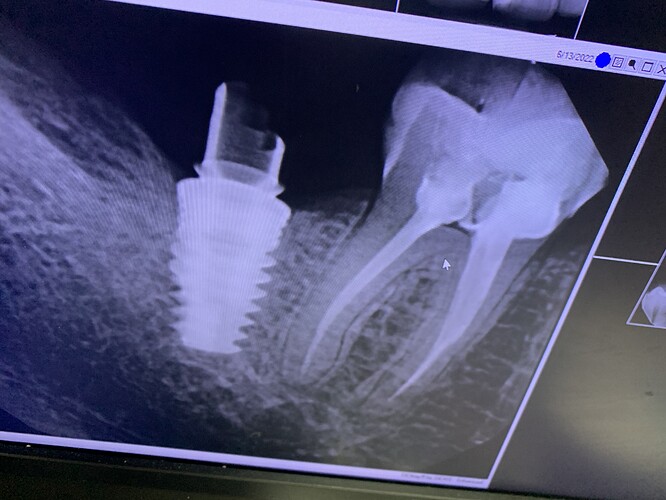#31 BSB Biomax Implant was restored with Tibase Zn screw retained in 2017. Crown became lose, broke off at the attempt to remove obturation material from the access channel. The abutment screw was unscrewed and removed. Tibase is stuck. Cold welding? Tapped on the side, pulled . No luck.
Any suggestions how to remove it?
If cannot remove it would you try to make a new cementable Zn crown over Tibase by packing cord and taking the impression?
Thank you for your help.
Robert Salisbury comments:
This is the result of cold weld. All conical's do this. Some more that others with steep angles. Some companies have a tool to pop up the abutment. Some don't. Should be a regulatory requirement. All conical slip down when torqueing and that is the main reason that why a bridge/bar cannot be fully sealed when the abutments are direct to the fixture. They recommend an additional abutment 9 Multi unit fort and then an impression to that so it controls the vertical slippage. Time will reveal all the ones that are leaking when they are not sealed properly. Think, Copper air/water compression fitting).That what’s make a tissue level attractive. But, its harder to place the implant and collar at thye same time.
Grind on the top with a rough bur to vibrate it loose . It will come. Do not rotate it as that may cause damage to the connection however, the type of connection is relative to the damage.
Best of luck.
Brad McLaughlin comments:
I'd try a couple things - small curette to try and ease the abutment off, being careful not to damage the implant. Another thing that might work is spraying the abutment with endo ice. This has worked before to help reverse the cold weld. Best of luck!Carlos Martínez comments:
Try ultrasonic works sometimesJason Larkin comments:
https://store.implantdirect.com/axs30.htmlCould try blast of endo ice on the abutment with rubber damage to protect tissue. This will contract the metal tibase.
Last effort is drill hole sideways through tibase, place ortho wire through, twist so there is a loop, use spring loaded bridge removal tool.
Best of luck.
prosdoc comments:
Sorry Jason, the abutment removal tool you show is for the zimmer product which has a threaded abutment. It's a great choice if the abutment has internal threads but if the abutment is not threaded then this will not work. straumann has an abutment retrieval tool that screws into the abutment. It gives a mechanical advantage with added length so you can rock the abutment back and forth to loosen it or grab it with hemostats to help pull the abutment out. As an aside, I never use tibases in high stress areas since there's very little surface area to cement the crown (see radiograph) and the walls are very thin and prone to breakage (again, see radiograph). A custom abutment with screw retained crown is a better and stronger long term solution.Michalis Tselepos comments:
Put the screw back in place and make Right-left front-back moves with the screw driver..This will help you to get the tibase looseTim Carter comments:
First of all it is a second molar and we could argue all day about it’s necessary or not. I would replace the screw and take an impression for a new crownMatt Helm D.D.S. comments:
All suggestions herein for breaking the cold weld are certainly valid. They may or may not work, and if none do, you'll be back to square one. The question you need to ask yourself is: why put yourself and your patient through all that? I prefer the KISS rule: "keep it simple s--pid". It's what clinical experience dictates and, has been proven untold times. You can certainly avoid the heartache and taxing the patient completely unnecessarily by making a cemented crown on the tibase you have available. It's simple, and it WORKS well. Let nature sort it out in time. IF that cold weld will ever break you can certainly reconstruct it all from scratch, just as you would if you removed the tibase now. Personally, I find the obsession --and insistence-- on screw retained crowns, as opposed to cemented, a bit overdone. Cemented crowns on implants work very well and they have many advantages over screw-retained. There is the advantage of occasionally becoming loose, thereby forcing the patient to come in for a check-up and implant hygiene. Since they are passive fit they are a bit gentler on the implant, transmitting less stress into the implant. Naturally, cemented crowns are more finicky when it comes to cement type, amount applied, and removal of excess cement from the sulcus. But the benefits are superior in many --if not most-- cases. These benefits include easier removal in case of mishap, and breaking down the component parts of the whole supra-implant construction to the point that they are easier to manage when removal is needed. There is also much less risk of fracture of the abutment-retaining screws, making life simpler for both dentist and patient. I have many roundhouses, both upper and lower, that are cement retained, and I wouldn't change them to screw-retained for anything in the world! Zero fractured abutment screws and zero implant margin fractures! Decades later gingival health is optimal, and no screw fractures whatsoever. Let the dissenters disagree as they will. Do yourself and your patient a favor, reinsert the screw, take a good impression with retraction cord, and fabricate a good old-fashioned cemented crown. The implant position and size lend themselves to it perfectly. You'll thank yourself and, most importantly, your patient will thank you. Good luck.